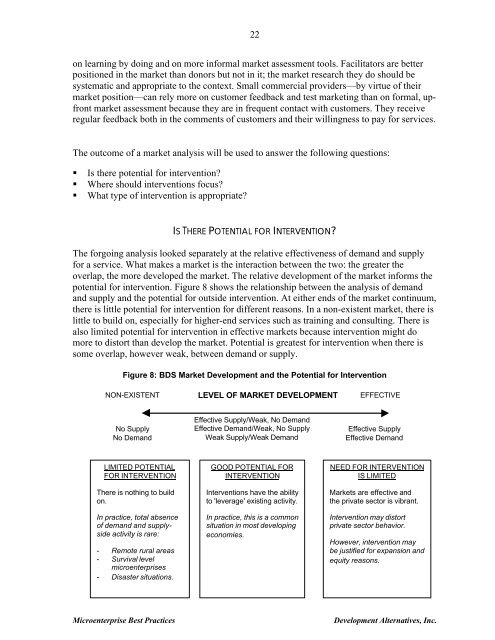BDS market development guide.pdf - PACA
BDS market development guide.pdf - PACA
BDS market development guide.pdf - PACA
Create successful ePaper yourself
Turn your PDF publications into a flip-book with our unique Google optimized e-Paper software.
22<br />
on learning by doing and on more informal <strong>market</strong> assessment tools. Facilitators are better<br />
positioned in the <strong>market</strong> than donors but not in it; the <strong>market</strong> research they do should be<br />
systematic and appropriate to the context. Small commercial providers—by virtue of their<br />
<strong>market</strong> position—can rely more on customer feedback and test <strong>market</strong>ing than on formal, upfront<br />
<strong>market</strong> assessment because they are in frequent contact with customers. They receive<br />
regular feedback both in the comments of customers and their willingness to pay for services.<br />
The outcome of a <strong>market</strong> analysis will be used to answer the following questions:<br />
• Is there potential for intervention?<br />
• Where should interventions focus?<br />
• What type of intervention is appropriate?<br />
IS THERE POTENTIAL FOR INTERVENTION?<br />
The forgoing analysis looked separately at the relative effectiveness of demand and supply<br />
for a service. What makes a <strong>market</strong> is the interaction between the two: the greater the<br />
overlap, the more developed the <strong>market</strong>. The relative <strong>development</strong> of the <strong>market</strong> informs the<br />
potential for intervention. Figure 8 shows the relationship between the analysis of demand<br />
and supply and the potential for outside intervention. At either ends of the <strong>market</strong> continuum,<br />
there is little potential for intervention for different reasons. In a non-existent <strong>market</strong>, there is<br />
little to build on, especially for higher-end services such as training and consulting. There is<br />
also limited potential for intervention in effective <strong>market</strong>s because intervention might do<br />
more to distort than develop the <strong>market</strong>. Potential is greatest for intervention when there is<br />
some overlap, however weak, between demand or supply.<br />
Figure 8: <strong>BDS</strong> Market Development and the Potential for Intervention<br />
NON-EXISTENT<br />
LEVEL OF MARKET DEVELOPMENT<br />
EFFECTIVE<br />
No Supply<br />
No Demand<br />
Effective Supply/Weak, No Demand<br />
Effective Demand/Weak, No Supply<br />
Weak Supply/Weak Demand<br />
Effective Supply<br />
Effective Demand<br />
LIMITED POTENTIAL<br />
FOR INTERVENTION<br />
There is nothing to build<br />
on.<br />
In practice, total absence<br />
of demand and supplyside<br />
activity is rare:<br />
- Remote rural areas<br />
- Survival level<br />
microenterprises<br />
- Disaster situations.<br />
GOOD POTENTIAL FOR<br />
INTERVENTION<br />
Interventions have the ability<br />
to 'leverage' existing activity.<br />
In practice, this is a common<br />
situation in most developing<br />
economies.<br />
NEED FOR INTERVENTION<br />
IS LIMITED<br />
Markets are effective and<br />
the private sector is vibrant.<br />
Intervention may distort<br />
private sector behavior.<br />
However, intervention may<br />
be justified for expansion and<br />
equity reasons.<br />
Microenterprise Best Practices<br />
Development Alternatives, Inc.














